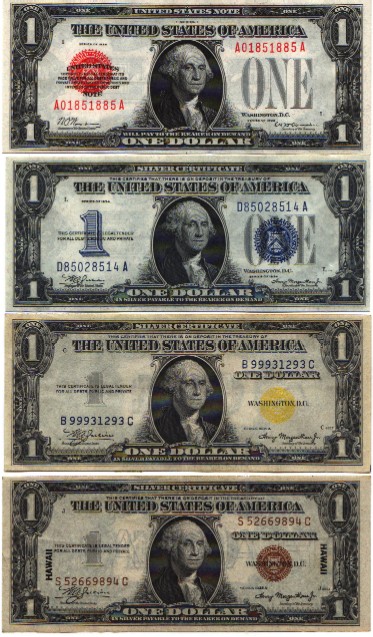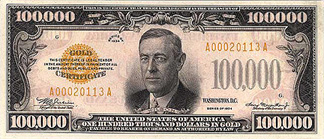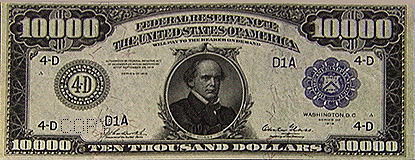The only difference between her novelty item and a real bill (besides the technical aspects of the type of paper and printing method) is the fact that our government says a $20 bill is “money”. That’s it: it’s money since the government says it is (fiat currency). If you think about it, it’s a little strange – we work for and then buy all sorts of goods and services by passing these little pieces of paper around. And more recently, all this is done virtually with bits of data being transferred between banks, credit unions, credit card companies and the like with no paper at all.
The evolution of money is an interesting topic and one of the reasons I got into collecting obsolete U.S. currency. Besides the historical and economic history in old currency, many of the old bills are like little pieces of art compared to the monopoly money our government is churning out today.
I am what is called a “type” collector. Once I get a type of currency I move on to the next note (other people collect series, serial numbers, portaits, signatures, the list is nearly endless). For example, here are just a few of the types of small-size $1 notes issued since 1928 (all from my collection):

Note that this small slice of my collection contains silver certificates and a U.S. note. Other types of money that have been issued include gold certificates, national bank notes, federal reserve bank notes (FRBN), and most recently federal reserve notes (FRN). This is another interesting aspect of collecting, which is understanding the different schemes the government has tried to create money.
Besides types of notes, U.S. currency can be broadly divided into “large size” and “small size” notes, the small size notes being the size of the notes in your wallet, which started being issued in 1928 as a way to save money on printing costs. Large size notes tend to be more expensive due to their age, but are also the most beautiful, interesting and rarest notes in the hobby since the larger size gave the engraver more space to show his craft, as shown by this obverse of the 1914 $1 Federal Reserve Bank Note (FRBN) in my collection:

And for that woman? She should have known that the largest bill ever printed by the U.S. government was $100,000, but was used only for internal transfers between the federal banks and never put (and illegal to posses) in private circulaiton

The largest bill ever printed for general circulation was $10,000, and although ALL U.S. currency ever issued is redeemable at face value at your nearest bank, this bill would fetch well into the six figures in a private sale (most known examples are in museums).

The largest "current" bill in circulation is $100, so if you see anything larger than this it is either a phony or worth a lot more than its face value as a collector's item ($1000 bills are still out there and worth anywhere from $1200 up, so don't spend them as cash).

1 comment:
What needs saying here is that those pieces of paper that you picture are not dollars. They are receipts for dollars. Even the United States Note¹ says "will pay to the bearer on demand One Dollar". And that is a fiat currency. The silver certificates each represent one actual dollar in silver for which they may be exchanged on demand. Only the monopoly² Federal Reserve Note has the audacity to declare that it is the dollar.
Today's dollars may be mediums of exchange and measures of value ... but they are not stores of value.
Luxomni on money
¹Very nice - and rare. Someday I will have one. I have an AU one hundred. It was only 130FRN. An EX one-dollar is 450FRN.
²Monopoly in either sense of the word.
Post a Comment